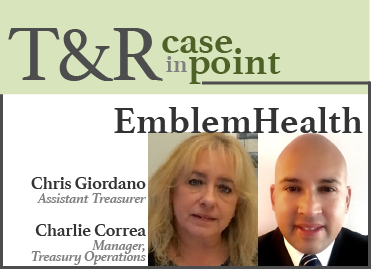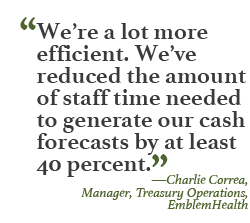 One of the largest nonprofit health plans in the United States, EmblemHealth serves 3.1 million people across the tri-state area around New York City. Despite the volume of its cash flows, however, until very recently EmblemHealth managed cash positioning and forecasting via spreadsheets.
One of the largest nonprofit health plans in the United States, EmblemHealth serves 3.1 million people across the tri-state area around New York City. Despite the volume of its cash flows, however, until very recently EmblemHealth managed cash positioning and forecasting via spreadsheets.
When the organization deployed a new treasury workstation module that automated cash management, it gained greater visibility into its current and future cash positions, while simultaneously streamlining treasury operations.
Treasury & Risk sat down with Chris Giordano, assistant treasurer for EmblemHealth, and Charlie Correa, manager of treasury operations, to talk about the project and the benefits they've achieved.
T&R: How did you handle cash forecasting in your legacy environment?
Chris Giordano: Two years ago, our forecasting capability was limited. Every day my staff would look at bank reports for the various entities that fall under the EmblemHealth umbrella. They'd pull out cash balances and plug those numbers into a spreadsheet called the Daily Cash Report. They would also add information about our cash investments.
These manual processes left room for error, and didn't enable us to take full advantage of potential investment opportunities. They also were time-consuming for our treasury staff.
Charlie Correa: Treasury staff not only had to input data manually, but also had to perform regular checks to make sure the formulas were correct.
T&R: So you decided to look for a more automated solution for treasury management?
CC: We were already using Kyriba's treasury management system for other things, so we talked to Kyriba about automating our cash position reporting and cash forecasting. They worked with us to make sure their forecasting module would meet our needs, and we decided to implement their solution.
CG: We put together a project team that was led by Charlie, with other representatives of the treasury operations team as well as some Kyriba staff. The project team's goal was to develop an easier method of calculating our daily forecast.
T&R: What does your cash forecasting look like now?
CC: Now we're using the Kyriba cash flow forecasting module. Each day's forecast is based on the prior day's activities. So when the BAI2 bank reports come in from all our banks each morning, they're automatically populating our forecast with all the previous day's transactions based on mapping rules we've created in the treasury workstation.
 The forecasting module then uses those prior-day actuals to forecast out to a 30-day cycle. We can go in and set rules to pick up an average for a specific item that we normally see, such as payroll, and the module will project that item out for 30 days. And for big items that we know are going to come in, we will manually enter them into the treasury workstation as a confirmed forecast, because we know that we need those specific dollars available at that particular time. But other than the occasional unexpected item, the forecasting module automatically assigns payments to the given days, indicating what is going to clear each day, which saves us from going in and doing the manual entry in the Excel sheet.
The forecasting module then uses those prior-day actuals to forecast out to a 30-day cycle. We can go in and set rules to pick up an average for a specific item that we normally see, such as payroll, and the module will project that item out for 30 days. And for big items that we know are going to come in, we will manually enter them into the treasury workstation as a confirmed forecast, because we know that we need those specific dollars available at that particular time. But other than the occasional unexpected item, the forecasting module automatically assigns payments to the given days, indicating what is going to clear each day, which saves us from going in and doing the manual entry in the Excel sheet.
CG: The bottom line is, when we have something new that's happening, that won't be on the BAI reports, we have to go in and put that in on the day we expect that money to come in or, vice versa, we expect money to go out. So there is some manual intervention, but not like it was before when we had to update Excel spreadsheets on a daily basis.
This cloud-based treasury software also puts us in a better position by giving us the opportunity to look at all of our bank accounts together and to forecast what cash flow will be. And since we're actually picking up the current cash position data automatically from the bank statements, we've eliminated some of the room for error that we had before.
T&R: Have payments changed as well?
 CG: Definitely. We're doing our wire transfers through Kyriba now, rather than having to go into each individual bank's portal. We used to have a keychain with several RSA tokens on it, and anytime we needed to do a wire transfer we'd have to get the right RSA token, then go into the right portal. Now it's so much more efficient. We go into Kyriba and initiate our wires, and we've set up the system so we don't have to enter every bank account and routing number and payee data. That information populates automatically. In this process, payments are better controlled because everything happens in one environment, the treasury workstation.
CG: Definitely. We're doing our wire transfers through Kyriba now, rather than having to go into each individual bank's portal. We used to have a keychain with several RSA tokens on it, and anytime we needed to do a wire transfer we'd have to get the right RSA token, then go into the right portal. Now it's so much more efficient. We go into Kyriba and initiate our wires, and we've set up the system so we don't have to enter every bank account and routing number and payee data. That information populates automatically. In this process, payments are better controlled because everything happens in one environment, the treasury workstation.
CG: Through automation, we're also able to get the cash forecast report out earlier in the day, which allows us to notify our investment staff that we have idle cash sitting for short-term investments.
T&R: Can you tell me how automating cash forecasting has affected your working capital management?
CG: We're now in a position to make more educated decisions based on actual cash flow. As I mentioned, we can make investments in a more timely manner to increase returns on excess cash. It also enables us to make adjustments more quickly. Having better visibility into our cash flows means we can keep our cash in investments with better returns to the point when we need that cash to fund, down the road.
CC: We send out the forecast to senior management on a daily basis. Before that forecast goes out, the treasury team discusses our cash position and where we're going to be in 30 days. Our cash forecasting analyst will advise senior management when excess cash will be needed.
T&R: What else has changed as a result of automating cash forecasting?
CC: We're a lot more efficient. When we enter a payment for intraday, it automatically populates in our cash flow forecast. That frees up more time for working on analysis and participating on project teams, rather than having us bogged down filling out an Excel spreadsheet. I'd say we've reduced the amount of staff time needed to generate our cash forecasts by at least 40 percent, especially for the analyst who manages this on a day-to-day basis. Also, because we're so much more efficient, we can do more analytics now than we used to.
CG: As an example, we're now producing a report based on remittances—what comes in via ACH, what comes in via checks, what comes in via lockbox payment, and what comes in via wires. We send that report out to senior management, in addition to the cash forecasting report. A year ago, we didn't have time to generate this report, but we do now because we have more time. And this is the sort of thing we should be doing.
CC: I believe we are moving toward being more than an operations department, toward being more strategic and analytical.
CG: It's also given us a chance to become more SMEs [subject matter experts] with respect to different projects related to banking. Whether it's disbursements, remittances, or receivables, we always have a seat at the table now. It's not just 'We need to open an account' or 'We need to establish a new lockbox.' People come to us to gather our opinion based on our expertise. We're lending value to the organization, and that's possible because we're running day-to-day treasury operations so much more efficiently.
The whole process has just made better reporting for treasury. And because we are so strategic to the organization—like most treasury divisions now—it frees up our time for more analytical work, to participate in projects. We're being pulled in constantly for our expertise in designing something. So I think that would be the ultimate benefit of doing this: using our skill sets in a more effective way that's strategically aligned with helping the organization.
© 2025 ALM Global, LLC, All Rights Reserved. Request academic re-use from www.copyright.com. All other uses, submit a request to [email protected]. For more information visit Asset & Logo Licensing.




